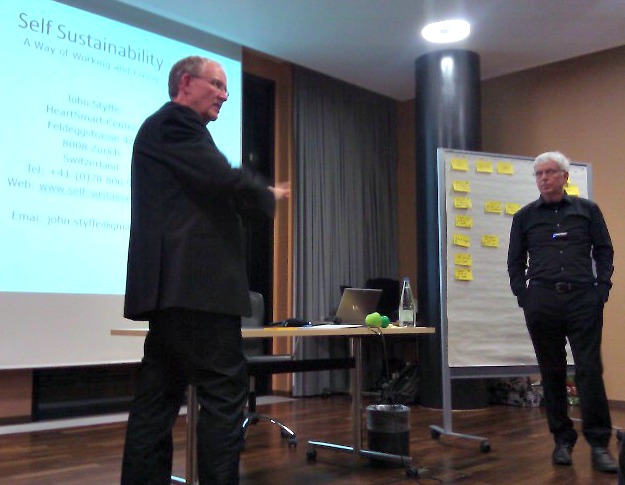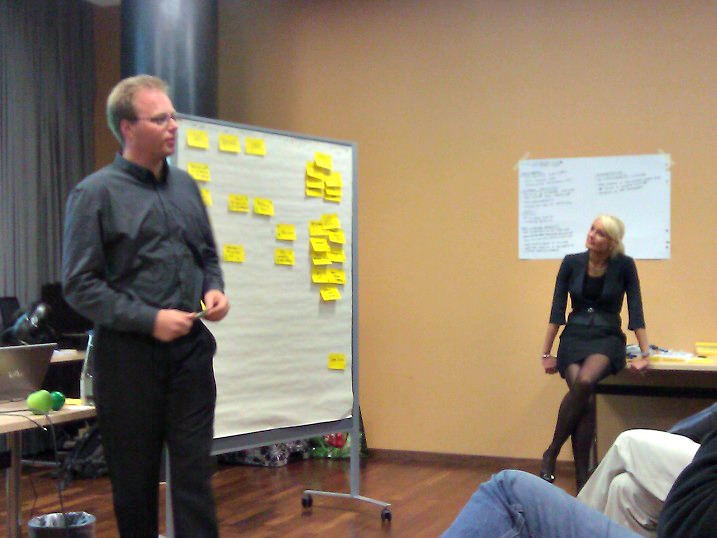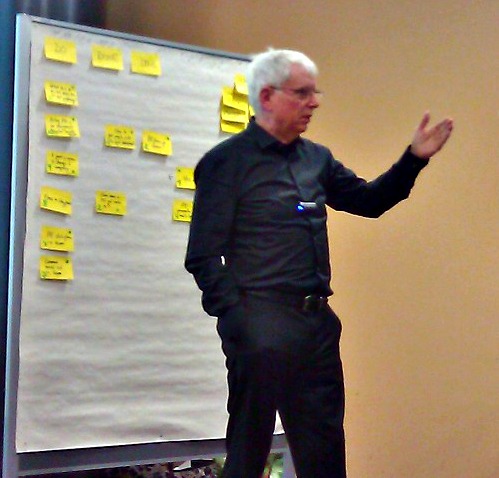John Styffe: The conventional waterfall command and control project management methodology is not necessarily best suited for dynamic web projects. On top, we are all different, have different backgrounds, genders, cultures, experience, etc. How can we possibly get along together? How can we not bring our personal problems to work?
John Styffe speaking at Trifork’s Scrum GOTO Night.

Being a product owner can be an exciting and challenging opportunity. What can prevent a person from becoming a «great» product owner are some of the old beliefs and perspective that one may have acquired in a previous work life.
Being a product owner will not only be a new way of working but also a new way of living. Becoming a product owner is not only about developing new skills in project management but also require change and growth personally. All that it takes is flexibility, courage and a desire to change ones perspective.
The Challenge of Change
Scrum is a model to help people to organise their work but also their life. It’s a mentality change, we change our mind and therefore our perspective.
Comfort zones are a sort of state of mind. People follow learned patterns. Our brain waves show different patterns called Delta (sleep), Theta (unfocused), Alpha (relaxed, reflective), Beta (concentration), High Beta (high alert).
Changing these learned patterns is doable but hard. E.g. by learning meditation, changing behavior or committing to a model like Scrum. It helps to change our patterns.
Multi tasking in a high anxiety state is leading to crash or burnout. It’s better to rest, task, rest, task, rest, etc. This allows to reenergise and offers a self sustainable model.
Each resource/person in a scrum team should be regarded as a very valuable resource. When you rest and do a retrospective you change your perspective. You will see yourself from the outside. This helps understanding what the other person needs. This also improves your ability to respond appropriately.
The Retrospective
Retrospectives can take from a few minutes to full blown workshops. You want to get away from the busy state of mind and break the patterns. But old patterns are only replaced by new patterns. To achieve that we need to practice.
Scrum
A narrow vision prevents people from being a great product owner. Lack of empathy, communication get’s in the way of being a great scrum master. Fear and a changing scope get’s in the way of successful scrum teams.
Product Owner
A clear vision is a necessary pattern for product owners. He needs an open state of mind.
«I know what I have to do but I just don’t do it!»
So what does it take to get motivated as a product owner?
- It takes a supportive environment (e.g. Scrum)
- Some structure (e.g. Scrum)
- Guidance (e.g. Scrum)
- Committment (Self)
- Courage to change (Self), what did I do wrong?
- Time (Self)
- Desire (Self)
It doesn’t matter whether we use Scrum, Kanban or any other framework that supports these key points.
Agile Tools
Become more calm, more focused. By meditation, yoga or mini retrospectives.
About John Styffe
 John has been a business consultant, public speaker, coach and trainer since 1998 in all areas of business. In his work he focuses on self sustainability for a better way of living and working. He is a co-developer of the «HeartSmart Process» which supports, encourages and guides people to self sustainability.
John has been a business consultant, public speaker, coach and trainer since 1998 in all areas of business. In his work he focuses on self sustainability for a better way of living and working. He is a co-developer of the «HeartSmart Process» which supports, encourages and guides people to self sustainability.
In his training he uses tools of measurement that provide objective feedback.
He is an active and founding member of the «Stoos» movement towards a better way of working http://www.stoosnetwork.org
Prior to his coaching career, John held various leadership and management positions in sales, insurance, import/export, operations and business development.
Moderator Klaus Bucka-Lassen, organiser Line Sorensen, John and Jeff Sutherland, Co-Creator of Scrum and a signer of the Agile Manifesto, answer questions from the audience:


How to Become a Good Scrum Product Owner - John Styffe - http://t.co/qKQFGlcG
— John Styffe (@JohnStyffe) November 16, 2012
@JohnStyffe How to become a good #Scrum #product #owner http://t.co/GbSaWQ1d interesting ideas! #CSPO #projectmanagement @JeffSutherland
— Walter Schärer (@WalterSchaerer) November 16, 2012
Ein Kommentar
An agile process tends to focus on iterations, and
client feedback, to allow for the inevitability of changing requirements
whereas a waterfall process tries to define all requirements up front, and
tends to be inflexible to changing requirements. You can learn more about agile
and scrum by referring to some free resources
(http://www.scrumstudy.com/free-resources.asp) provided by scrumstudy or by attending any agile scrum certification
courses. I would personally suggest Agile Expert Certified course or a Scrum
Master Certification to you.